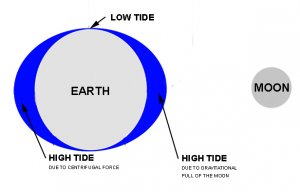Why High Tide Can be Zero to 30 feet

Boat at the Dock on the Bay of Fundy moves up and down almost 30 feet (9 m) with the daily tide. (Photo: Samuel Wantman)
High and low tide is easily observed wherever land meets the ocean. Almost twice a day beaches change size. Boats at dock move up and down. The vertical height change is typically a few feet – almost a meter. Yet strangely in some places the daily tide height is up to 30 feet (9 meters), and in other places zero. Not only can the amount of tidal change vary greatly but even the number of tides daily can vary as I will explain.

High Tide can be once a day (diurnal) or twice daily (semidiurnal). Twice daily tides can be the same height or mixed.
As shown on the map above, in some places there are two tide cycles each day, but in others only one (diurnal). Without getting too technical it’s worth understanding tides, if for no other reason than to learn about a mysterious tidal force that will actually cause the rate of sea level rise to slow over the next eight years, possibly even going down. To keep this easy to understand, I will break this information into two separate blog posts, with part 2 next week.

When the Sun is in line with the Moon, their combined gravitational pull causes larger than normal tides, occurring at the full moon and new moon every two weeks.
Three or four months a year, when the moon’s orbit is closer to Earth (perigee) making the gravitational force even stronger, the monthly high tides are extra high. (In some areas there is also a seasonal effect.) Such extreme tides are often referred to as “king tides” – more noticeable in recent years as the flooding gets worse, pushed ever higher by rising sea level. In Florida these flood days are now called sunny day flood events.
A few other points about the tides may be interesting:
- Each day has almost two full tidal cycles. Each tide cycle is 12 hours 25 minutes (and 12 seconds) long. With two cycles being an Earth day, plus 50 minutes–a little more than a day– the time for high tide progresses almost an hour each day.
[Just for ‘science geeks”, the reason for this is that the Earth and Moon are moving in the same direction, so each day the moon has to travel farther to catch up with the same point on the Earth. An analogy is that an hour and minute hand on a clock are together at 12 o’clock. The next time they are together will be about five and a half minutes past 1. The difference between Earth and Lunar days is similar.]
- The tidal bulge is affected by land forms that can trap some of the moving of the bulge of seawater causing it to “pile up” higher. As the tidal bulge moves past the long Chesapeake Bay for example, the effect will be amplified as the water bulge gets pushed into a confined area. As an extreme example, where the water is pushed up into a long bay or river, it becomes a very dynamic “tidal bore.” Examples are the Bay of Fundy in Canada – see the images at top – or the Quiantang River in China. Both have daily tidal cycles reaching thirty feet (9 meters).
- In addition to the pull of moon and sun, the other major tidal force is the Coriolis Effect, caused by the spin of the Earth. As that drives various ocean currents around underwater topographic features, it may add to the moving tidal bulge, or may act to counteract it. As a result some places have different height high tides each day, some have only one high tide each day, and some have absolutely no tidal change. (Examples are off of Newfoundland, Perth, and Iceland. For more, look up Amphidromic Points)
Our understanding of the tides has an interesting history. The first recognized attribution of the Tides being related to the moon, was in 150 B.C. and then centuries later by several astronomers in Europe and the Muslim world. In 1609, Johannes Kepler gave an accurate explanation refined by Issac Newton in 1687. Interestingly in 1632 Galileo wrote a “Dialogue with the Tides” that somewhat incorrectly attributed the movement to a sloshing of water due to the movement of the Earth around the Sun. (For those that want to understand the tides better, I highly recommend a very readable and fascinating book by Jonathan White, appropriately titled “Tides.”)
Mysterious 19 year super cycle
Next week in part 2, I will explain that we have just passed the peak of a little-known phenomenon, the 19 year tidal epoch, known as the lunar nodal cycle. It partly explains why sea level has risen so quickly for the last decade in some areas.
However, we are now in the downward phase that will have a negative effect on the rate of sea level rise for the until the year 2024. Climate change skeptics (and others) will likely use that slow down or downturn to suggest the era of rising sea level is coming to an end. Hardly! Next week: “Sea Level Falling Until 2024.”
